Feng Qiao
GenStereo: Towards Open-World Generation of Stereo Images and Unsupervised Matching
Mar 17, 2025Abstract:Stereo images are fundamental to numerous applications, including extended reality (XR) devices, autonomous driving, and robotics. Unfortunately, acquiring high-quality stereo images remains challenging due to the precise calibration requirements of dual-camera setups and the complexity of obtaining accurate, dense disparity maps. Existing stereo image generation methods typically focus on either visual quality for viewing or geometric accuracy for matching, but not both. We introduce GenStereo, a diffusion-based approach, to bridge this gap. The method includes two primary innovations (1) conditioning the diffusion process on a disparity-aware coordinate embedding and a warped input image, allowing for more precise stereo alignment than previous methods, and (2) an adaptive fusion mechanism that intelligently combines the diffusion-generated image with a warped image, improving both realism and disparity consistency. Through extensive training on 11 diverse stereo datasets, GenStereo demonstrates strong generalization ability. GenStereo achieves state-of-the-art performance in both stereo image generation and unsupervised stereo matching tasks. Our framework eliminates the need for complex hardware setups while enabling high-quality stereo image generation, making it valuable for both real-world applications and unsupervised learning scenarios. Project page is available at https://qjizhi.github.io/genstereo
MCPDepth: Omnidirectional Depth Estimation via Stereo Matching from Multi-Cylindrical Panoramas
Aug 03, 2024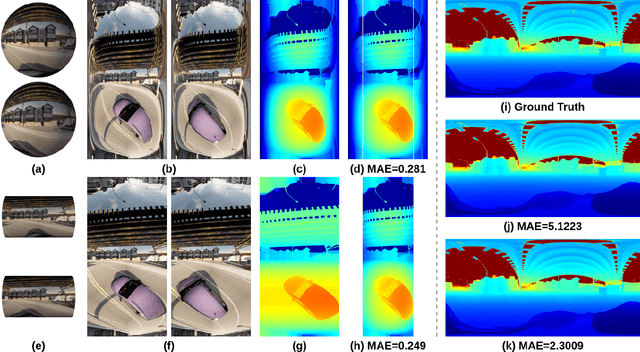
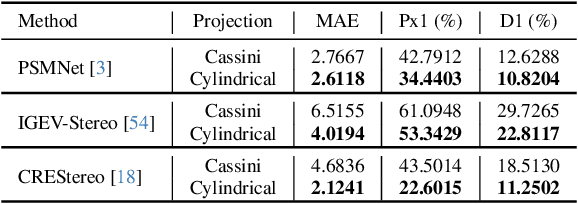
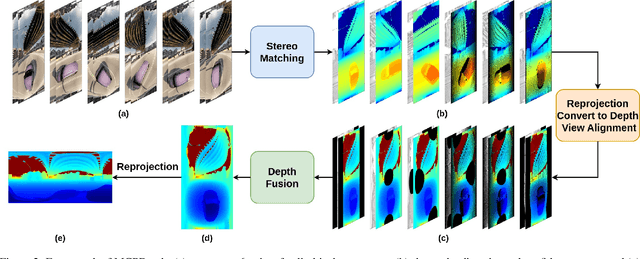

Abstract:We introduce Multi-Cylindrical Panoramic Depth Estimation (MCPDepth), a two-stage framework for omnidirectional depth estimation via stereo matching between multiple cylindrical panoramas. MCPDepth uses cylindrical panoramas for initial stereo matching and then fuses the resulting depth maps across views. A circular attention module is employed to overcome the distortion along the vertical axis. MCPDepth exclusively utilizes standard network components, simplifying deployment to embedded devices and outperforming previous methods that require custom kernels. We theoretically and experimentally compare spherical and cylindrical projections for stereo matching, highlighting the advantages of the cylindrical projection. MCPDepth achieves state-of-the-art performance with an 18.8% reduction in mean absolute error (MAE) for depth on the outdoor synthetic dataset Deep360 and a 19.9% reduction on the indoor real-scene dataset 3D60.
SAM-guided Unsupervised Domain Adaptation for 3D Segmentation
Oct 16, 2023Abstract:Unsupervised domain adaptation (UDA) in 3D segmentation tasks presents a formidable challenge, primarily stemming from the sparse and unordered nature of point cloud data. Especially for LiDAR point clouds, the domain discrepancy becomes obvious across varying capture scenes, fluctuating weather conditions, and the diverse array of LiDAR devices in use. While previous UDA methodologies have often sought to mitigate this gap by aligning features between source and target domains, this approach falls short when applied to 3D segmentation due to the substantial domain variations. Inspired by the remarkable generalization capabilities exhibited by the vision foundation model, SAM, in the realm of image segmentation, our approach leverages the wealth of general knowledge embedded within SAM to unify feature representations across diverse 3D domains and further solves the 3D domain adaptation problem. Specifically, we harness the corresponding images associated with point clouds to facilitate knowledge transfer and propose an innovative hybrid feature augmentation methodology, which significantly enhances the alignment between the 3D feature space and SAM's feature space, operating at both the scene and instance levels. Our method is evaluated on many widely-recognized datasets and achieves state-of-the-art performance.
StereoFlowGAN: Co-training for Stereo and Flow with Unsupervised Domain Adaptation
Sep 04, 2023



Abstract:We introduce a novel training strategy for stereo matching and optical flow estimation that utilizes image-to-image translation between synthetic and real image domains. Our approach enables the training of models that excel in real image scenarios while relying solely on ground-truth information from synthetic images. To facilitate task-agnostic domain adaptation and the training of task-specific components, we introduce a bidirectional feature warping module that handles both left-right and forward-backward directions. Experimental results show competitive performance over previous domain translation-based methods, which substantiate the efficacy of our proposed framework, effectively leveraging the benefits of unsupervised domain adaptation, stereo matching, and optical flow estimation.
DUFormer: A Novel Architecture for Power Line Segmentation of Aerial Images
Apr 12, 2023Abstract:Power lines pose a significant safety threat to unmanned aerial vehicles (UAVs) operating at low altitudes. However, detecting power lines in aerial images is challenging due to the small size of the foreground data (i.e., power lines) and the abundance of background information. To address this challenge, we propose DUFormer, a semantic segmentation algorithm designed specifically for power line detection in aerial images. We assume that performing sufficient feature extraction with a convolutional neural network (CNN) that has a strong inductive bias is beneficial for training an efficient Transformer model. To this end, we propose a heavy token encoder responsible for overlapping feature re-mining and tokenization. The encoder comprises a pyramid CNN feature extraction module and a power line feature enhancement module. Following sufficient feature extraction for power lines, the feature fusion is carried out, and then the Transformer block is used for global modeling. The final segmentation result is obtained by fusing local and global features in the decode head. Additionally, we demonstrate the significance of the joint multi-weight loss function in power line segmentation. The experimental results demonstrate that our proposed method achieves the state-of-the-art performance in power line segmentation on the publicly available TTPLA dataset.
QuadFormer: Quadruple Transformer for Unsupervised Domain Adaptation in Power Line Segmentation of Aerial Images
Nov 29, 2022Abstract:Accurate segmentation of power lines in aerial images is essential to ensure the flight safety of aerial vehicles. Acquiring high-quality ground truth annotations for training a deep learning model is a laborious process. Therefore, developing algorithms that can leverage knowledge from labelled synthetic data to unlabelled real images is highly demanded. This process is studied in Unsupervised domain adaptation (UDA). Recent approaches to self-training have achieved remarkable performance in UDA for semantic segmentation, which trains a model with pseudo labels on the target domain. However, the pseudo labels are noisy due to a discrepancy in the two data distributions. We identify that context dependency is important for bridging this domain gap. Motivated by this, we propose QuadFormer, a novel framework designed for domain adaptive semantic segmentation. The hierarchical quadruple transformer combines cross-attention and self-attention mechanisms to adapt transferable context. Based on cross-attentive and self-attentive feature representations, we introduce a pseudo label correction scheme to online denoise the pseudo labels and reduce the domain gap. Additionally, we present two datasets - ARPLSyn and ARPLReal to further advance research in unsupervised domain adaptive powerline segmentation. Finally, experimental results indicate that our method achieves state-of-the-art performance for the domain adaptive power line segmentation on ARPLSyn$\rightarrow$TTTPLA and ARPLSyn$\rightarrow$ARPLReal.
STCrowd: A Multimodal Dataset for Pedestrian Perception in Crowded Scenes
Apr 03, 2022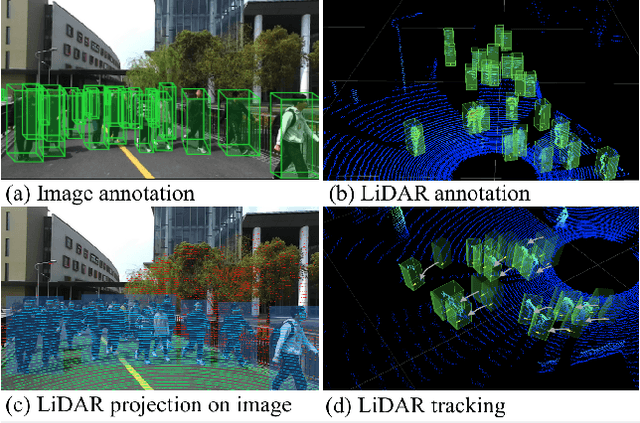



Abstract:Accurately detecting and tracking pedestrians in 3D space is challenging due to large variations in rotations, poses and scales. The situation becomes even worse for dense crowds with severe occlusions. However, existing benchmarks either only provide 2D annotations, or have limited 3D annotations with low-density pedestrian distribution, making it difficult to build a reliable pedestrian perception system especially in crowded scenes. To better evaluate pedestrian perception algorithms in crowded scenarios, we introduce a large-scale multimodal dataset,STCrowd. Specifically, in STCrowd, there are a total of 219 K pedestrian instances and 20 persons per frame on average, with various levels of occlusion. We provide synchronized LiDAR point clouds and camera images as well as their corresponding 3D labels and joint IDs. STCrowd can be used for various tasks, including LiDAR-only, image-only, and sensor-fusion based pedestrian detection and tracking. We provide baselines for most of the tasks. In addition, considering the property of sparse global distribution and density-varying local distribution of pedestrians, we further propose a novel method, Density-aware Hierarchical heatmap Aggregation (DHA), to enhance pedestrian perception in crowded scenes. Extensive experiments show that our new method achieves state-of-the-art performance for pedestrian detection on various datasets.
MetaSAug: Meta Semantic Augmentation for Long-Tailed Visual Recognition
Apr 07, 2021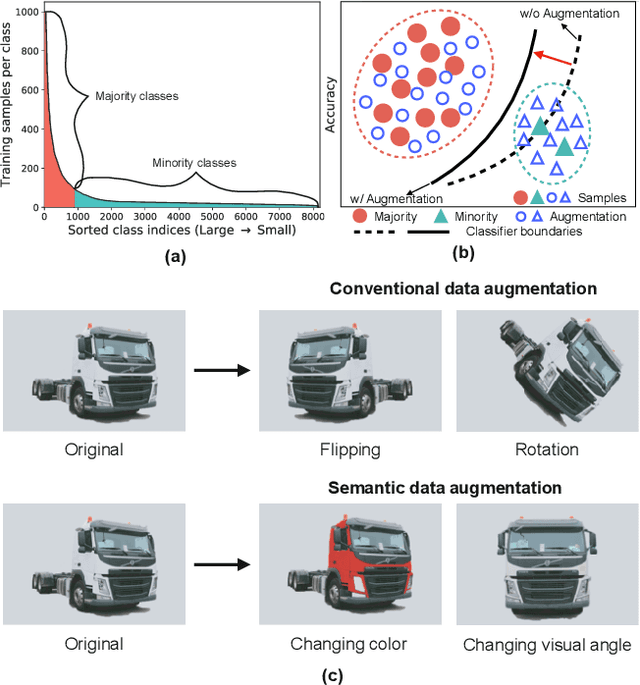
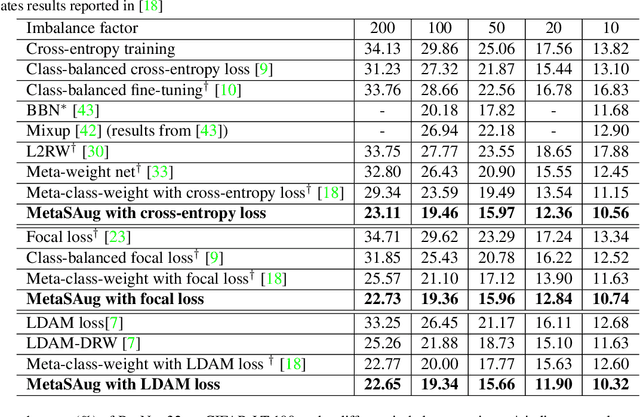
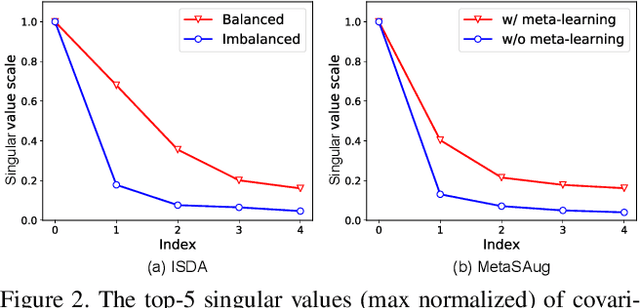
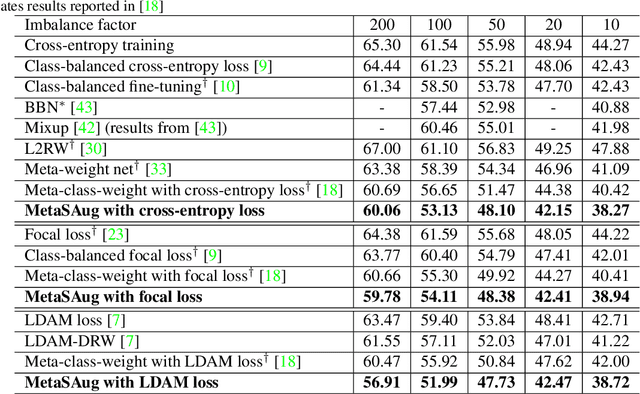
Abstract:Real-world training data usually exhibits long-tailed distribution, where several majority classes have a significantly larger number of samples than the remaining minority classes. This imbalance degrades the performance of typical supervised learning algorithms designed for balanced training sets. In this paper, we address this issue by augmenting minority classes with a recently proposed implicit semantic data augmentation (ISDA) algorithm, which produces diversified augmented samples by translating deep features along many semantically meaningful directions. Importantly, given that ISDA estimates the class-conditional statistics to obtain semantic directions, we find it ineffective to do this on minority classes due to the insufficient training data. To this end, we propose a novel approach to learn transformed semantic directions with meta-learning automatically. In specific, the augmentation strategy during training is dynamically optimized, aiming to minimize the loss on a small balanced validation set, which is approximated via a meta update step. Extensive empirical results on CIFAR-LT-10/100, ImageNet-LT, and iNaturalist 2017/2018 validate the effectiveness of our method.
 Add to Chrome
Add to Chrome Add to Firefox
Add to Firefox Add to Edge
Add to Edge